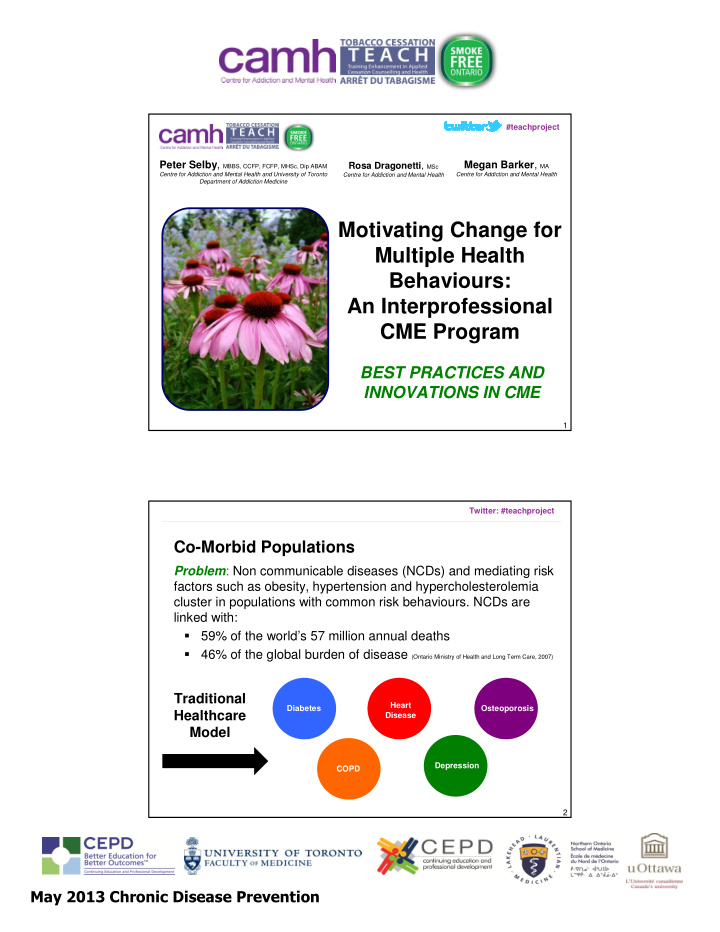



#teachproject Peter Selby , MBBS, CCFP, FCFP, MHSc, Dip ABAM Megan Barker , MA Rosa Dragonetti , MSc Centre for Addiction and Mental Health and University of Toronto Centre for Addiction and Mental Health Centre for Addiction and Mental Health Department of Addiction Medicine Motivating Change for Multiple Health Behaviours: An Interprofessional CME Program BEST PRACTICES AND INNOVATIONS IN CME 1 Twitter: #teachproject Co-Morbid Populations Problem : Non communicable diseases (NCDs) and mediating risk factors such as obesity, hypertension and hypercholesterolemia cluster in populations with common risk behaviours. NCDs are linked with: � 59% of the world’s 57 million annual deaths � 46% of the global burden of disease (Ontario Ministry of Health and Long Term Care, 2007) Traditional Heart Diabetes Osteoporosis Healthcare Disease Model Depression COPD 2 �����������������������������������
Twitter: #teachproject Integrated Health Promotion Solution: Increase capacity among healthcare practitioners with innovative education to address co-morbid chronic disease in an integrated way. MODIFIABLE BEHAVIOURAL INTERMEDIATE SELECTED PHYSICAL/ RISK FACTORS CHRONIC PHYSIOLOGICAL DISEASES Smoking RISK FACTORS Cardiovascular Physical Activity High blood pressure Disease Alcohol Cholesterol/lipids Diabetes Nutrition Glucose intolerance Cancer Stress Tolerance Overweight/obesity Mental Health Sleep 3 Twitter: #teachproject Integrated Chronic Disease Prevention: Addressing the Risks An integrated, interprofessional CME program � Two-day specialty course � Offered 8 times since 2010 (7 English, 1 French) � 613 professionals from <15 disciplines trained � Overall satisfaction rating of 4.56/5 (5=highest/best) � Interprofessional faculty engaged (physicians, psychiatrists, nurses, dietitians, social workers and pharmacists) 4 �����������������������������������
Twitter: #teachproject Participant Demographics 5 Twitter: #teachproject Participant Demographics 6 �����������������������������������
Twitter: #teachproject Course Model: The Health Promotion-6 Pack (HP-6) 7 Twitter: #teachproject Achieving the HP-6 Pack Reduce drinking No smoking to or below low risk drinking guidelines 5 servings of 30 minutes or fruits and more of physical vegetables activity per day per day 7 to 9 hours Manage stress of sleep per effectively- night family, friends 8 �����������������������������������
Biopsychosocial Framework: Twitter: #teachproject E nvironment, B ehaviour, B iology ENVIRONMENT BEHAVIOUR BIOLOGY Dr. Peter Selby (2010) 9 Twitter: #teachproject Course content is delivered in a highly interactive style emphasizing case- based learning and application of skills. ����������������������� ���� ���� ������� ������� ������� ����������� ������� �������� ���� ���� ��� ���� ������� ������� ������� 10 �����������������������������������
Twitter: #teachproject Overall Learning Assessment Results (All 8 courses to date) Scale: 0 = Very Low, 10 = Very High * * * *p<0.01 Learning Assessments measure practitioners’ ratings of feasibility, importance, and confidence in implementing knowledge and skills pre- and post- course. Ratings increased significantly post training, and 97.0% set practice objectives. 11 Twitter: #teachproject a c . h m a c @ y b l e s . r e t e g p n i k o m S t i u Q S P a @ c . t c e j o r p h c a e t . w w w �����������������������������������
Recommend
More recommend